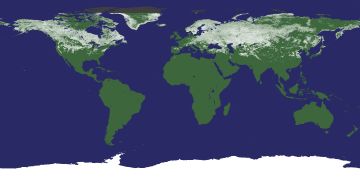
 |
||
|
|
||
| View other datasets |
|
|
| ||
 |
|||
| Coverage of this dataset spans March 2000 to February 2006. | |||
The animation features of the Earth Observatory are currently unavailable. We apologize for the inconvenience. To view the full temporal span of this dataset, please view the Snow Cover monthly holdings. | |||
 Product description: Scientists monitor global snow cover to better understand short- and long-term environmental and climatic conditions. On a seasonal scale, the depth and extent of the winter snowpack influence water availability and soil moisture, which, in turn, affect agriculture and wildfire potential. In many places around the world, the melting of the winter snowpack is the major source of fresh water in the spring and summer. In climate terms, snow cover is important because it changes how reflective the surface of the Earth is. As anyone who has forgotten their sunglasses on a sunny day on the ski slopes can tell you, snow is highly reflective. The highly reflective nature of snow combined with its potential to cover large areas of our world make it an important factor in Earth’s balance of incoming and outgoing radiant energy. Typically, snow covers more than 40 percent of the Earth’s land surface in the Northern Hemisphere during the winter months, and reflects up to 80 or 90 percent of the incoming solar energy, compared to the 10-20 of solar energy that bare ground reflects. The map above represents snow cover detected by NASA’sModerate Resolution Imaging Spectroradiometer (MODIS) for the month indicated. The percent of each 1-degree by 1-degree area on the Earth that was snow-covered during that time is shown in white. Green areas have no snow. Visualizations by Reto Stockli, Earth Observatory, based on data provided by the MODIS Science Team, NASA Goddard Space Flight Center
|
|
Subscribe to the Earth Observatory About the Earth Observatory Contact Us Privacy Policy and Important Notices Responsible NASA Official: Lorraine A. Remer Webmaster: Goran Halusa We're a part of the Science Mission Directorate |